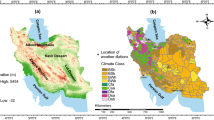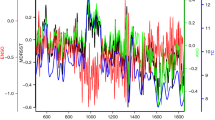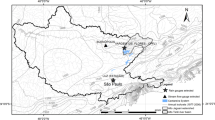Abstract
In the context of the ongoing United Nations Framework Convention on Climate Change (UNFCCC) process, it seems important to focus attention not only on global mean surface air temperature (GSMT) but also on the climate of specific regions in order to gain insights into the dynamics of the changes, the timescales of the periodic components, the local trends and the relationships between climatic variables in the region of interest. This is important for scientists as well as for policymakers. This paper provides an analysis of the changes in local air temperature and precipitation depth in exceptionally long observational records and examines the relationships between these two variables. The focus is on monthly values. Temperature maximum, minimum, range, and cumulative precipitation depth are considered. The wavelet analysis shows that the scale of variation is different for temperature and precipitation and that the behavior of the temperature range values diverges from the behavior of the minimum and maximum values. The timescale of important changes in the long-term trend is, however, similar. Results also suggest that the main mode of variability is persistent through time in the series of temperature maximum, minimum, and range but not in precipitation depth. This is a clear evidence of climate change. All series show variances that change over time and are, as expected, nonstationary. The analysis of the wavelet coherence shows that the relationship between precipitation and temperature evolves through time, and its intensity varies considering different time scales. The association between these climatic variables is particularly strong in the last decade. Is it noteworthy that the analysis of the coherence suggests that temperature is leading to rain and not the other way around. This highlights the impact of global warming on the hydrologic cycle and on related human activities.




















Similar content being viewed by others
Data availability
The datasets generated during and/or analyzed during the current study are available from the corresponding author on reasonable request.
References
Akansu AN, Smith MJ (1995) Subband and wavelet transforms: design and applications, vol 340. Springer, New York
Akansu AN, Haddad RA, Caglar H (1992) Multiresolution signal decomposition: transforms, subbands, and wavelets. MA Academic Press, Boston
Aldrich E (2020) Wavelets: functions for computing wavelet filters, wavelet transforms and multiresolution analyses. R package version 0.3-0.2. https://CRAN.R-project.org/package=wavelets
Beaulieu C, Killick R, Ireland D, Norwood B (2020) Considering long-memory when testing for changepoints in surface temperature: a classification approach based on the time-varying spectrum. Environmetrics 31(1):2568
Boucher O, Reddy MS (2008) Climate trade-off between black carbon and carbon dioxide emissions. Energy Policy 36(1):327–343
Braganza K, Karoly DJ, Hirst AC, Mann ME, Stott PA, Stouffer RJ, Tett SFB (2003) Simple indices of global climate variability and change: part I, variability and correlation structure. Clim Dyn 20:491–502
Braganza K, Karoly DJ, Arblaster JM (2004) Diurnal temperature range as an index of global climate change during the twentieth century. Geophys Res Lett 31. https://doi.org/10.1029/2004GL01999
Broecker W (2012) The carbon cycle and climate change: memoirs of my 60 years in science. Geochem Perspect 1(2):221–340
Cazelles B, Chavez M, Berteaux D, Menard F, Vik JO, Jenouvrier S, Stenseth NC (2008) Wavelet analysis of ecological time series. Oecologia 156:287–304
Chatfield JR (1989) The analysis of time series: an introduction. Chapman and Hall, London
Chui CK (1992) An introduction to wavelets. Academic Press, Cambridge
Dai A, Trenberth KE, Karl TR (1999) Effects of clouds, soil moisture, precipitation and water vapor on diurnal temperature range. J Clim 12:2451–2473
Daubechies I (1988) Orthonormal bases of compactly supported wavelet. Commun Pure Appl Math 41(7):909–946
Daubechies I (1992) Ten lectures on wavelets. SIAM monographs, Philadelphia
De Laat ATJ, Maurellis AN (2004) Industrial Co2 emissions as a proxy for anthropogenic influence on lower tropospheric temperature trends. Geophys Res Lett 31(5)
Donoho DL, David L, Johonstone JM (1994) Ideal spatial adaptation by wavelet shrinkage. Commun Pure Appl Math 81(3):425–455
Easterling DR, Peterson TC, Karl TR (1996) On the development and use of homogenized climate data sets. J Clim 9:1429–1434
Easterling DR, Horton B, Jones PD et al (1997) Maximum and minimum temperature trends for the globe. Science 227:364–367
Elayouty A, Scott M, Miller C, Waldron S, Franco-Villoria M (2016) Challenges in modeling detailed and complex environmental data sets: a case study modeling the excess partial pressure of fluvial CO\(_2\). Environ Ecol Stat 23(1):65–87
Gallegati M (2018) A systematic wavelet-based exploratory analysis of climatic variables. Clim Change 148:325–338
Gambis D (1992) Wavelets transform analysis of the length of the day and the el Nino southern oscillation variations ate intra-seasonal and inter-annual time scale. Ann Geophys 10:429–437
Gao W, Li BL (1992) Wavelets analysis of coherent structure at the atmosphere forest interface. J Appl Meteor 32:1717–1725
Gouhier TC, Grinsted A, Simko V (2021) R package biwavelet: conduct univariate and bivariate wavelet analyses (Version 0.20.21). https://github.com/tgouhier/biwavelet
Grinsted A, Moore JC, Jevrejeva S (2004) Application of the cross wavelet transform and wavelet coherence to geophysical time series. Nonlinear Process Geophys 11:561–566. https://doi.org/10.5194/hess-20-3183-2016
Hansen JE, Lebedeff S (1987) Global trends of measured surface air temperature. J Geophys Res 92:13345–13372
Hansen J, Johnson D, Lacis A, Lebedeff S, Lee P, Rind D, Russel G (1981) Climate impact of increasing atmospheric carbon dioxide. Science 213(4511):957–966
Hansen J, Ruedy R, Sato M, Lo K (2010) Global surface temperature range. Rev Geophys. https://doi.org/10.1029/2010RG000345
Hua L, Ma Z, Guo W (2008) The impact of urbanization on air temperature across china. Theoret Appl Climatol 93(3):179–194
Kalnay E, Cai M (2003) Impact of urbanization and land-use change on climate. Nature 423(6939):528–531
Karl B, Karoly DJ, Arblaster JM (2004) Diurnal temperature range as an index of global climate change during the twentieth century. Geophys Res Lett 31:13217
Korkas KK, Fryzlewicz P (2017) Multiple change-point detection for non-stationary time series using wild binary segmentation. Stat Sin 27:287–311
Kumar P, Foufoula-Georgiou E (1993) A new look at rainfall fluctuations and scaling properties of spatial rainfall using orthogonal wavelets. J Appl Meteor 32:209–222
Lau KM, Weng H (1995) Climatic signal detection using wavelet transform: how to make a time Serie Sing. Bull Am Meteorol Soc 76:2391–2402
Leathers DJ, Palecki MA, Robinson NA, Dewey KF (1998) Climatology of the daily temperature range annual Cicle in the united states. Clim Res 9:197–211
Makowski K, Wild M, Ohmura A (2008) Diurnal temperature range over Europe between 1950 and 2005. Atmos Chem Phys 8:6483–6498
Mallat S (1999) A wavelet tour of signal processing. CA Academic, San Diego
Maraun D, Kurths J (2004) Cross wavelet analysis: significance testing and pitfalls. Nonlinear Process Geophys 11:505–514. https://doi.org/10.5194/npg-11-505-2004
Maraun D, Kurths J, Holschneider M (2007) Non-stationary gaussian processes in wavelet domain: definitions, estimation and significance testing. Phys Rev E. https://doi.org/10.1103/PhysRevE.75.016707
McGonigle ET, Killick R, Nunes MA (2022) Trend locally stationary wavelet processes. J Time Ser Anal 43(6):895–917
Mi X, Rend Z, Ouyang H, Wei W, Ma K (2005) The use of the Mexican hat and the Morlet wavelets for detection of ecological patterns. Plant Ecol 179, 1–19. https://doi.org/10.1007/s11258-004-5089-4
Nason G (2013) A test for second-order stationarity and approximate confidence intervals for localized autocovariances for locally stationary time series. J R Stat Soc 879–904
Nason GP, Von Sachs R, Kroisandt G (2000) Wavelet processes and adaptive estimation of the evolutionary wavelet spectrum. J R Stat Soc 62(2):271–292
Ozbay N, Toker S (2021) Prediction framework in a distributed lag model with a target function: an application to global warming data. Environ Ecol Stat 28:87–134. https://doi.org/10.1007/s10651-020-00477-x
Percival DB, Walden AT (2000) Wavelet methods for time series analysis. Cambridge University Press, Cambridge
Qu M, Wan J, Hao X (2014) Analysis of diurnal air temperature range change in the continental united states. Weather Clim Extremes 4:86–95. https://doi.org/10.1016/j.wace.2014.05.002
R Core Team (2021) R: a language and environment for statistical computing. R Foundation for Statistical Computing, Vienna, Austria, R Foundation for Statistical Computing. https://www.R-project.org/
Ruskal MB, Beylkin G, Coifman R, Daubechies I, Mallat S, Meyer Y, Raphael L (1992) Wavelets and their applications. Jones and Bartlett, Burlington
Schulte JA (2016) Cumulative areawise testing in wavelet analysis and its application to geophysical time series. Nonlinear Process Geophys 23:45–57. https://doi.org/10.5194/npg-23-45-2016
Schulte JA (2016) Wavelet analysis for non-stationary, nonlinear time series. Nonlinear Process Geophys 23:257–267. https://doi.org/10.5194/npg-23-257-2016
Schulte JA (2019) Statistical hypothesis testing in wavelet analysis: theoretical developments and applications to Indian rainfall. Nonlinear Process Geophys 26:91–108
Schulte JA, Duffy C, Najjar RG (2015) Geometric and topological approaches to significance testing in wavelet analysis. Nonlinear Process Geophys 22:139–156. https://doi.org/10.5194/npg-22-139-2015
Simmons AJ, Willett KM, Jones PD, Thorne PW, Dee DP (2010) Low-frequency variations in surface atmospheric humidity, temperature, and precipitation: inferences from reanalyses and monthly gridded observational data sets. J Geophys Res. https://doi.org/10.1029/2009JD012442
Stone DA, Weaver AJ (2002) Daily maximum and minimum temperature trends in a climate model. Geophys Res Lett 29(9):1356. https://doi.org/10.1029/2001GL014556
Stone DA, Weaver AJ (2003) Factors contributing to diurnal temperature range trends in twentieth and twenty-first century simulations of the CCMA coupled model. Clim Dyn 12:2451–2473
Sun D, Pinker R, Kafatos M (2006) Diurnal temperature range over the united states: a satellite view. Geophys Res Lett 33:05705
Sutton R, Suckling E, Hawkins E (2015) What does global mean temperature tell us about local climate? Philosophical transactions. Ser A Math Phys Eng Sci. https://doi.org/10.1098/rsta.2014.0426
Thompson DWJ, Wallace JM, Jones PD, Kennedy JJ (2009) Identifying signatures of natural climate variability in time series of global-mean surface temperature: methodology and insights. J Clim 22:6120–6141
Torrence C, Compo GP (1998) A parctical guide to wavelet analysis. Bull Am Meteorol Soc 79:61–78
Torrence C, Webster P (1999) Interdecadal changes in the Esno-Monsoon system. J Clim 12:2679–2690
Woody J, Lu Q, Livsey J (2020) Statistical methods for forecasting daily snow depths and assessing trends in inter-annual snow depth dynamics. Environ Ecol Stat 27:609–628. https://doi.org/10.1007/s10651-020-00461-5
Acknowledgements
The research reported in the present paper was supported by Fondazione Cassa di Risparmio di Modena through the Grant 2018-0093, by the University of Modena and Reggio Emilia through the Grant FAR 2020 Mission Oriented, and by the European Union NextGenerationEU/NRRP, Mission 4 Component 2 Investment 1.5, Call 3277 (12/30/2021), Award 0001052 (06/23/2022), under the Project ECS00000033 “Ecosystem for Sustainable Transition in Emilia-Romagna,” Spoke 6 “Ecological Transition Based on HPC and Data Technology.” The authors thank the anonymous reviewer for comments that led to improvements in the manuscript.
Author information
Authors and Affiliations
Corresponding author
Ethics declarations
Conflict of interest
The authors declare no conflicts of interest relevant to this study.
Additional information
Handling Editor: Luiz Duczmal
Rights and permissions
Springer Nature or its licensor (e.g. a society or other partner) holds exclusive rights to this article under a publishing agreement with the author(s) or other rightsholder(s); author self-archiving of the accepted manuscript version of this article is solely governed by the terms of such publishing agreement and applicable law.
About this article
Cite this article
Morlini, I., Franco-Villoria, M. & Orlandini, S. Modelling local climate change using site-based data. Environ Ecol Stat 30, 205–232 (2023). https://doi.org/10.1007/s10651-023-00560-z
Received:
Revised:
Accepted:
Published:
Issue Date:
DOI: https://doi.org/10.1007/s10651-023-00560-z




